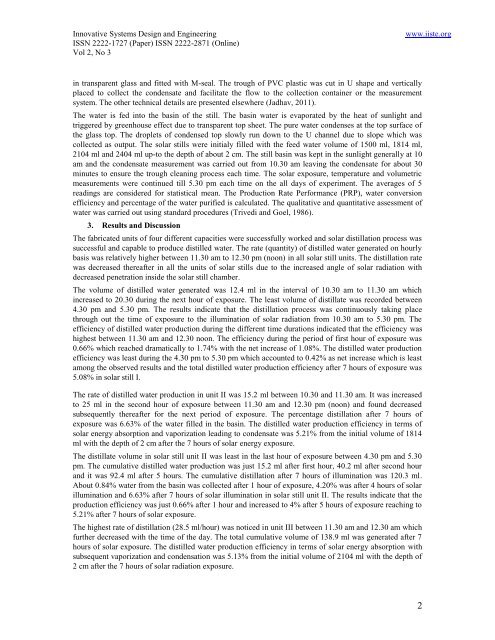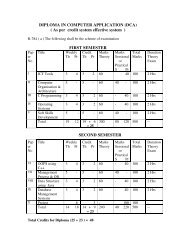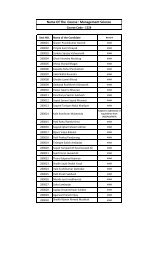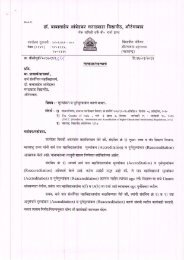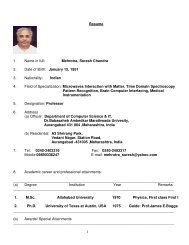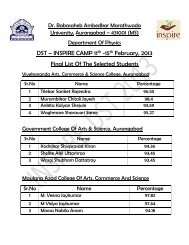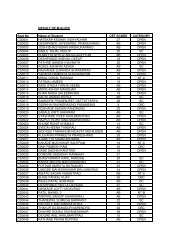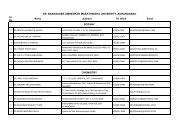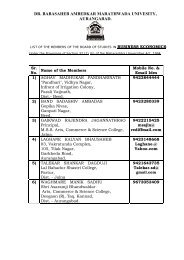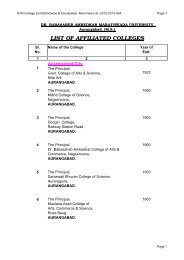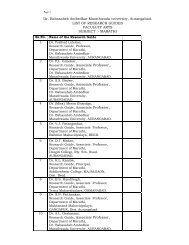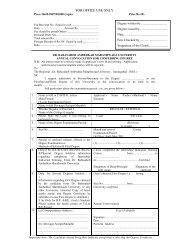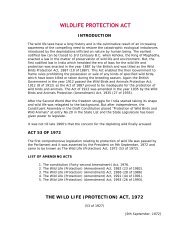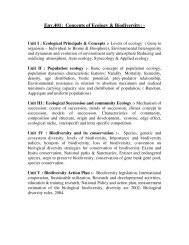1 Issue : 2 November 2011 - Dr.Babasaheb Ambedkar Marathwada ...
1 Issue : 2 November 2011 - Dr.Babasaheb Ambedkar Marathwada ...
1 Issue : 2 November 2011 - Dr.Babasaheb Ambedkar Marathwada ...
Create successful ePaper yourself
Turn your PDF publications into a flip-book with our unique Google optimized e-Paper software.
Innovative Systems Design and Engineering www.iiste.org<br />
ISSN 2222-1727 (Paper) ISSN 2222-2871 (Online)<br />
Vol 2, No 3<br />
in transparent glass and fitted with M-seal. The trough of PVC plastic was cut in U shape and vertically<br />
placed to collect the condensate and facilitate the flow to the collection container or the measurement<br />
system. The other technical details are presented elsewhere (Jadhav, <strong>2011</strong>).<br />
The water is fed into the basin of the still. The basin water is evaporated by the heat of sunlight and<br />
triggered by greenhouse effect due to transparent top sheet. The pure water condenses at the top surface of<br />
the glass top. The droplets of condensed top slowly run down to the U channel due to slope which was<br />
collected as output. The solar stills were initialy filled with the feed water volume of 1500 ml, 1814 ml,<br />
2104 ml and 2404 ml up-to the depth of about 2 cm. The still basin was kept in the sunlight generally at 10<br />
am and the condensate measurement was carried out from 10.30 am leaving the condensate for about 30<br />
minutes to ensure the trough cleaning process each time. The solar exposure, temperature and volumetric<br />
measurements were continued till 5.30 pm each time on the all days of experiment. The averages of 5<br />
readings are considered for statistical mean. The Production Rate Performance (PRP), water conversion<br />
efficiency and percentage of the water purified is calculated. The qualitative and quantitative assessment of<br />
water was carried out using standard procedures (Trivedi and Goel, 1986).<br />
3. Results and Discussion<br />
The fabricated units of four different capacities were successfully worked and solar distillation process was<br />
successful and capable to produce distilled water. The rate (quantity) of distilled water generated on hourly<br />
basis was relatively higher between 11.30 am to 12.30 pm (noon) in all solar still units. The distillation rate<br />
was decreased thereafter in all the units of solar stills due to the increased angle of solar radiation with<br />
decreased penetration inside the solar still chamber.<br />
The volume of distilled water generated was 12.4 ml in the interval of 10.30 am to 11.30 am which<br />
increased to 20.30 during the next hour of exposure. The least volume of distillate was recorded between<br />
4.30 pm and 5.30 pm. The results indicate that the distillation process was continuously taking place<br />
through out the time of exposure to the illumination of solar radiation from 10.30 am to 5.30 pm. The<br />
efficiency of distilled water production during the different time durations indicated that the efficiency was<br />
highest between 11.30 am and 12.30 noon. The efficiency during the period of first hour of exposure was<br />
0.66% which reached dramatically to 1.74% with the net increase of 1.08%. The distilled water production<br />
efficiency was least during the 4.30 pm to 5.30 pm which accounted to 0.42% as net increase which is least<br />
among the observed results and the total distilled water production efficiency after 7 hours of exposure was<br />
5.08% in solar still I.<br />
The rate of distilled water production in unit II was 15.2 ml between 10.30 and 11.30 am. It was increased<br />
to 25 ml in the second hour of exposure between 11.30 am and 12.30 pm (noon) and found decreased<br />
subsequently thereafter for the next period of exposure. The percentage distillation after 7 hours of<br />
exposure was 6.63% of the water filled in the basin. The distilled water production efficiency in terms of<br />
solar energy absorption and vaporization leading to condensate was 5.21% from the initial volume of 1814<br />
ml with the depth of 2 cm after the 7 hours of solar energy exposure.<br />
The distillate volume in solar still unit II was least in the last hour of exposure between 4.30 pm and 5.30<br />
pm. The cumulative distilled water production was just 15.2 ml after first hour, 40.2 ml after second hour<br />
and it was 92.4 ml after 5 hours. The cumulative distillation after 7 hours of illumination was 120.3 ml.<br />
About 0.84% water from the basin was collected after 1 hour of exposure, 4.20% was after 4 hours of solar<br />
illumination and 6.63% after 7 hours of solar illumination in solar still unit II. The results indicate that the<br />
production efficiency was just 0.66% after 1 hour and increased to 4% after 5 hours of exposure reaching to<br />
5.21% after 7 hours of solar exposure.<br />
The highest rate of distillation (28.5 ml/hour) was noticed in unit III between 11.30 am and 12.30 am which<br />
further decreased with the time of the day. The total cumulative volume of 138.9 ml was generated after 7<br />
hours of solar exposure. The distilled water production efficiency in terms of solar energy absorption with<br />
subsequent vaporization and condensation was 5.13% from the initial volume of 2104 ml with the depth of<br />
2 cm after the 7 hours of solar radiation exposure.<br />
2


